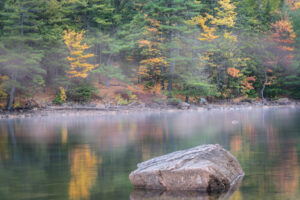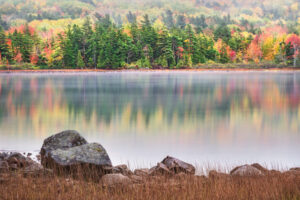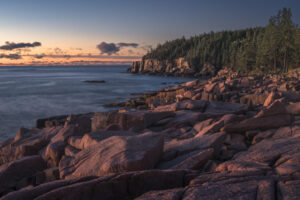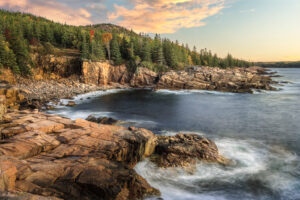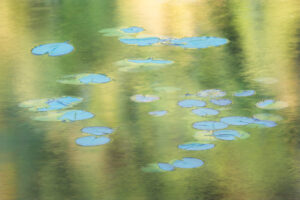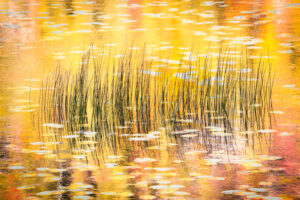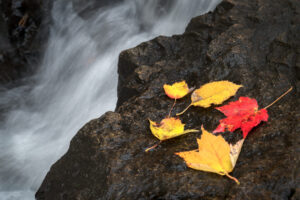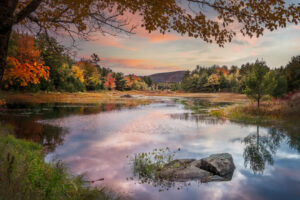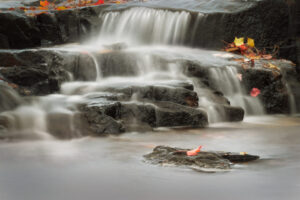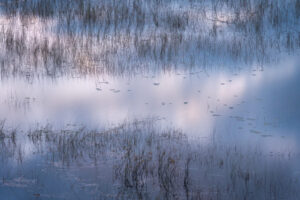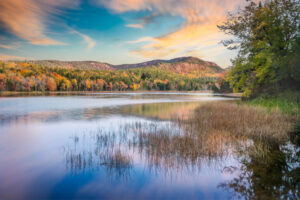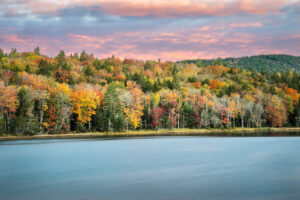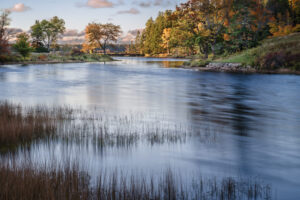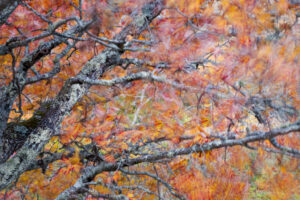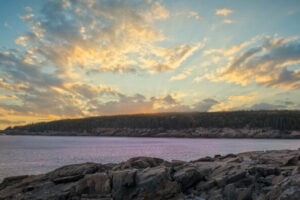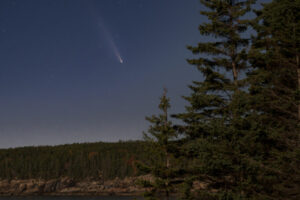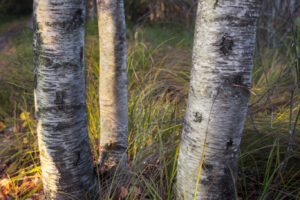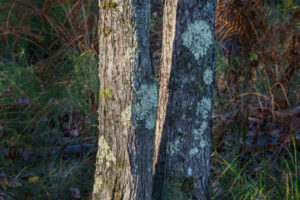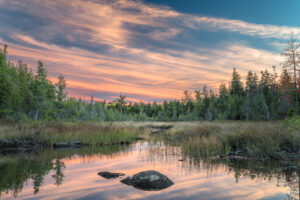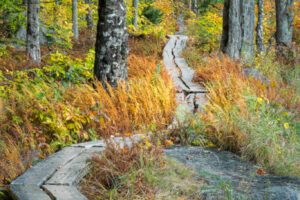Encompassing nearly 50,000 acres along the Atlantic coastline of Maine, Acadia National Park includes Mount Desert Island, Schoodic Peninsula, Isle au Haut and other outer islands. With more than 60 miles of coastline, 33 miles of scenic motor roads, 45 miles of carriage roads and more than 150 miles of hiking trails, it is a gem in downeast Maine.
Acadia’s jagged coastlines, peaceful woodlands, still ponds, dense pine forests, towering mountains and pristine lakes are a playground for photographers. Such iconic sites as Thunder Hole, Bass Harbor lighthouse, Cadillac Mountain, Jordan Pond and many others offer both grandeur and subtle beauty. Early morning light is particularly magical in Acadia, and sometimes fog rolls in from the sea, creating a soft, ethereal atmosphere that enhances the textures of the coastal cliffs dotted with twisted, wind-sculpted trees.
At sunrise, Cadillac Mountain – the highest point on the U.S. East Coast – is a premier location, especially during autumn when the hills are draped in fiery foliage. The intense contrast between the crisp blue of the Atlantic and the vibrant fall colors creates compositions that feel both timeless and powerful. Nearby, Jordan Pond provides opportunities for capturing near-perfect reflections of the “Bubbles,” two distinctive rounded hills, in its mirror-like surface.
Acadia’s charm extends throughout the year. Spring bursts forth with delicate wildflowers and soft greens. Summer delivers warm days, cool nights, and plenty of sunshine. Autumn brings vibrant foliage, including shades of red, orange, yellow, purple and brown. Winter transforms the park into a serene, snow-dusted wonderland.
Whether photographing the rocky coastline under the moody skies of a nor’easter or capturing the delicate details of moss and lichen in shaded woodlands, Acadia demands a keen eye and patience. It’s a place where a photographer can find endless inspiration in the quiet interplay of light, texture, and the raw power of nature.
- Eagle Lake Mist and Reflections Acadia Natioinal Park, Maine | October 2024
- Eagle Lake Fall Color Acadia Natioinal Park, Maine | Oct 2024
- Sunrise I Near Monument Cove, Acadia Natioinal Park, Maine | Oct 2024
- First Rays of Light Near Monument Cove, Acadia Natioinal Park, Maine | Oct 2024
- Monumnet Cove Sunrise Acadia Natioinal Park, Maine | Oct 2024
- Waves on Rocks Near Monument Cove, Acadia Natioinal Park, Maine | Oct 2024
- Water Lilies The Tarn, Acadia Natioinal Park, Maine | Oct 2024
- Reeds in Gold The Tarn, Acadia Natioinal Park, Maine | Oct 2024
- Water and Leaves in Motion I Duck Brook, Acadia Natioinal Park, Maine | Oct 2024
- Leaves Duck Brook, Acadia Natioinal Park, Maine | Oct 2024
- Water and Leaves in Motion II Duck Brook, Acadia Natioinal Park, Maine | Oct 2024
- Beaver Pond Duck Brook, Acadia Natioinal Park, Maine | Oct 2024
- Cascade Duck Brook, Acadia Natioinal Park, Maine | Oct 2024
- Cloud Reflections Duck Brook, Acadia Natioinal Park, Maine | Oct 2024
- Morning at Little Long Pond I Acadia Natioinal Park, Maine | Oct 2024
- Morning at Little Long Pond II Acadia Natioinal Park, Maine | Oct 2024
- Morning at Little Long Pond III Acadia Natioinal Park, Maine | Oct 2024
- Colors in Motion Little Long Pond, Acadia Natioinal Park, Maine | Oct 2024
- Otter Point Sunset Acadia Natioinal Park, Maine | Oct 2024
- Comet Tsuchinshan-ATLAS Otter Point, Acadia Natioinal Park, Maine | Oct 2024
- Morning LIght on Trees I Sieur de Monts, Acadia Natioinal Park, Maine | Oct 2024
- Morning LIght on Trees II Sieur de Monts, Acadia Natioinal Park, Maine | Oct 2024
- Jesup Path Sieur de Monts, Acadia Natioinal Park, Maine | Oct 2024
- Jordan Pond Sunset Acadia Natioinal Park, Maine | Oct 2024
- Kane Path Acadia Natioinal Park, Maine | Oct 2024

